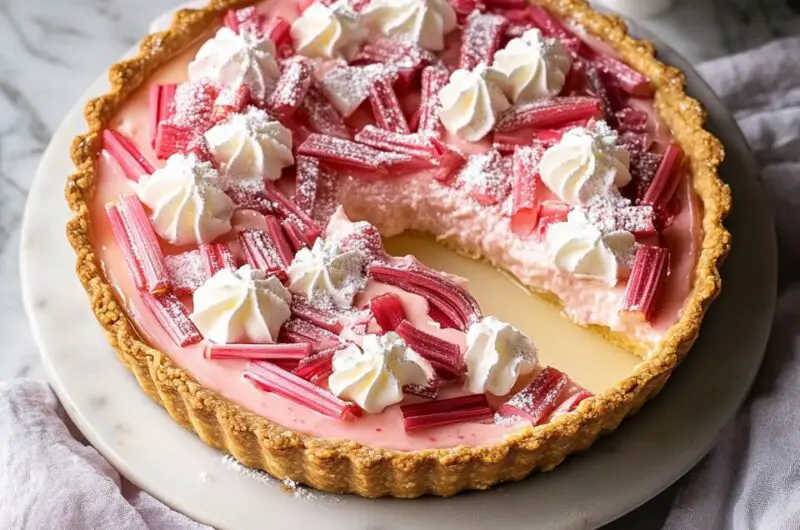The Rhubarb Cream Tart is a sophisticated and seasonal dessert that perfectly balances tartness with sweet creaminess. With a flaky, buttery crust and a custard infused with vanilla and cardamom, this dish celebrates the unique flavor of fresh rhubarb. It’s perfect for showcasing spring produce in a show-stopping dessert. This tart is a stunning centerpiece for any brunch, tea, or dinner party. The creamy custard melts into every bite, while the rhubarb offers bright acidity that cuts through the richness. The hint of cardamom adds depth and a subtle spice, elevating the overall flavor. It’s easy to make yet impressive to serve, making it a keeper for your dessert rotation.
Full Recipe:
Ingredients:
For the Crust:
-
1 1/4 cups all-purpose flour
-
1/2 cup unsalted butter, cold and cubed
-
1/4 cup granulated sugar
-
1/4 teaspoon salt
-
1 large egg yolk
-
1-2 tablespoons cold water
For the Filling:
-
3/4 cup heavy cream
-
2 large eggs
-
1/3 cup granulated sugar
-
1/2 teaspoon vanilla extract
-
1/4 teaspoon ground cardamom
-
2 cups rhubarb, sliced into 1/2-inch pieces
To Serve:
-
Powdered sugar, for dusting (optional)
Directions:
-
In a food processor, combine flour, sugar, and salt. Add cold butter and pulse until the mixture resembles coarse crumbs.
-
Add egg yolk and pulse, adding cold water a little at a time until the dough just comes together.
-
Press the dough into a 9-inch tart pan. Chill for 30 minutes.
-
Preheat oven to 375°F (190°C). Prick the tart crust with a fork and blind bake with pie weights for 15 minutes. Remove weights and bake 10 minutes more.
-
While crust cools slightly, whisk together cream, eggs, sugar, vanilla, and cardamom until smooth.
-
Arrange rhubarb evenly in the crust. Pour cream mixture over top.
-
Bake 30–35 minutes, until the center is just set and the top is lightly golden.
-
Cool completely before serving. Dust with powdered sugar if desired.
Prep Time: 20 minutes | Cooking Time: 50 minutes | Total Time: 1 hour 10 minutes
Kcal: 310 kcal | Servings: 8 servings
The Allure of Seasonal Baking
Few things evoke the essence of spring and early summer like a freshly baked Rhubarb Cream Tart. With its vibrant hue, tart-sweet flavor, and creamy custard filling encased in a buttery shortcrust pastry, this dessert is the perfect celebration of the season’s bounty. Though rhubarb may be humble and underutilized in modern kitchens, its sharp tang and striking color make it an excellent candidate for elegant desserts that are both nostalgic and refined.
In this article, we’ll explore the origins and characteristics of rhubarb, delve into why this tart is a culinary gem, and offer insight into how it can be used to elevate your spring or summer table. Whether you’re a home baker, a culinary enthusiast, or a food blogger looking to connect your audience with seasonal recipes, this dish has all the qualities to become a recurring favorite.
Rhubarb: A Fruit or a Vegetable?
Let’s begin by addressing a common question: Is rhubarb a fruit or a vegetable? Botanically, rhubarb is a vegetable, belonging to the family Polygonaceae. However, in the culinary world, it’s treated as a fruit because of how it is prepared often sweetened and paired with desserts.
Originating from Asia, rhubarb was initially cultivated for medicinal purposes, prized for its roots rather than its stalks. It wasn’t until the 18th century that rhubarb made its way into kitchens in Europe and North America, especially when sugar became more widely available to balance out its naturally sour flavor.
Today, rhubarb is a seasonal favorite, most abundant in spring and early summer. Its unique taste and dramatic color lend themselves beautifully to tarts, pies, compotes, and jams.
Why Rhubarb Pairs Perfectly with Cream
Rhubarb’s inherent sharpness is what makes it stand out in desserts. However, its acidity needs a counterpart enter cream. The rich, smooth texture of cream tames the sourness of rhubarb and creates an irresistible mouthfeel.
In the Rhubarb Cream Tart, this dynamic contrast is taken to another level. The custard, made with heavy cream, eggs, and often a touch of vanilla or cardamom, is silky and luxurious. It envelops the rhubarb, allowing it to soften while maintaining its integrity. Every bite becomes a beautiful balance of sharp, mellow, and buttery notes.
Adding a subtle spice like cardamom enhances this synergy. Cardamom’s warm, citrusy character complements the brightness of rhubarb without overpowering the dish. The result is layered and complex, yet approachable an ideal combination for those who want a dessert that feels both comforting and elevated.
The Art of Shortcrust Pastry
The base of the tart plays an essential role in the overall texture and flavor. A shortcrust pastry offers a firm, crumbly structure that holds the creamy filling while adding its own richness from butter and a light sweetness.
While it’s a simple dough, mastering shortcrust pastry requires an understanding of cold ingredients, light handling, and proper chilling. The reward is a crust that’s flaky yet tender, providing the perfect contrast to the soft custard and fruit.
Some bakers opt for an almond flour variation or a touch of citrus zest in the dough to complement the rhubarb filling. Whether kept classic or tweaked for extra nuance, the crust must remain a solid yet subtle foundation for the star ingredients.
Serving Suggestions and Variations
The Rhubarb Cream Tart is versatile enough to be served in a variety of settings:
-
Afternoon Tea or Brunch: Its light, tangy notes and beautiful appearance make it an ideal accompaniment to tea, coffee, or sparkling wine.
-
Dessert for Elegant Dinners: Its composed presentation suits it well for formal dining or celebratory occasions.
-
Garden Parties or Potlucks: Served cold or at room temperature, it’s easy to transport and slice, making it perfect for picnics and outdoor gatherings.
You can also experiment with several variations:
-
Add Strawberries: Combine sliced strawberries with rhubarb for a classic flavor pairing.
-
Infuse the Cream: Use lavender, orange zest, or vanilla bean in the cream for extra aromatic depth.
-
Top with Whipped Cream or Meringue: This adds volume and elegance to each serving.
The tart is best served chilled, with a dusting of powdered sugar or a dollop of crème fraîche. Its flavor intensifies after a few hours, making it a great make-ahead option.
A Dessert with Cultural Resonance
Rhubarb desserts have deep roots in many cultures, particularly in Northern and Central Europe. In the UK, rhubarb is often stewed or baked into crumbles. In Germany, “Rhabarberkuchen” (rhubarb cake) is a common springtime treat. Scandinavian countries also embrace rhubarb for its tart freshness, often pairing it with dairy in puddings and tarts.
The Rhubarb Cream Tart brings together these European traditions in a format that feels both timeless and modern. The custard element is reminiscent of French patisserie, while the rustic appeal of the fruit keeps the dish grounded and familiar.
As food culture continues to embrace seasonal and sustainable eating, rhubarb’s comeback has been significant. Recipes like this tart highlight local, in-season produce while inviting bakers to celebrate their culinary heritage in new ways.
Advertisement
Storage and Leftovers
If you have leftovers (though that’s rare!), store the tart in the refrigerator in an airtight container. It keeps well for up to 3 days, though the crust may soften slightly over time. The flavors tend to deepen after a day, making it even more delicious the next morning.
You can also freeze individual slices wrapped tightly in plastic wrap and foil for up to one month. Thaw in the refrigerator overnight and reheat gently or enjoy cold.
Conclusion:
The Rhubarb Cream Tart is more than just a dessert it’s a celebration of spring’s fleeting beauty. The vibrant stalks, velvety custard, and delicate crust combine in a dish that pleases the eye as much as the palate. Its balance of sweet, tart, creamy, and crisp makes it unforgettable.
Whether you’re baking it for a special occasion or just want to capture the season in a single dish, this tart is a worthy centerpiece. And best of all, it offers endless room for creativity. Switch up the spices, swap in different fruits, or change the crust to suit your dietary needs the framework is as flexible as it is delicious.








